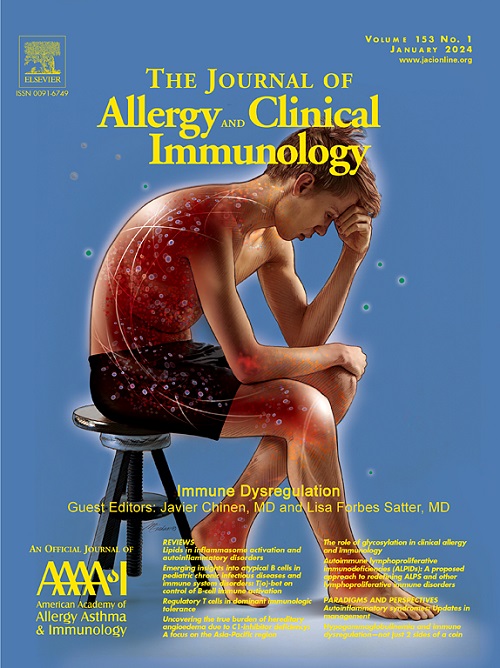Single-cell transcriptomic profiling of eosinophils and airway immune cells in childhood asthma
IF 11.2
1区 医学
Q1 ALLERGY
引用次数: 0
Abstract
Background
Single-cell RNA sequencing has transformed our understanding of cellular heterogeneity but remains inadequate in capturing granulocytes, particularly in tissue compartments, owing to technical limitations.
Objective
To enhance granulocyte recovery in single-cell RNA sequencing, we used nasal lavage samples from children with asthma, leveraging the 10× Genomics Flex platform combined with a customized data processing pipeline.
Methods
Nasal lavage samples were processed without prior manipulation to avoid technical artifacts such as lysis or stimulation. Granulocyte recovery was optimized by using fixation to preserve cell quality and advanced computational techniques to separate cells with a low RNA content from background noise. Cell-type proportions were validated against histologic and bulk RNA data.
Results
The optimized approach achieved more than a16-fold increase in eosinophil detection versus in standard methods. This method successfully captured eosinophils, neutrophils, and other major cell types in proportions consistent with histologic and bulk RNA assessments, with no biased loss of cell types. Phenotypic comparisons between children with high-eosinophil and low-eosinophil asthma uncovered significant transcriptional differences, cell composition, and distinct biologic pathways in granulocytes, immune cells, and epithelial cells. Additionally, distinct subpopulations of eosinophils and neutrophils with unique functional profiles were identified; the identified subpopulations were uniquely associated with high- and low-eosinophil asthma phenotypes, highlighting the complexity of airway granulocyte inflammation.
Conclusions
This study provides a framework for efficient capture of granulocytes in tissue compartments, overcoming traditional limitations. The resulting data set serves as a valuable resource for understanding airway granulocyte biology and inflammation, enabling detailed exploration of asthma pathogenesis. Furthermore, this approach facilitates large-scale, multicenter translational studies and advances personalized therapeutic strategies for airway diseases.
儿童哮喘中嗜酸性粒细胞和气道免疫细胞的单细胞转录组学分析。
单细胞RNA测序(scRNA-seq)已经改变了我们对细胞异质性的理解,但由于技术限制,在捕获粒细胞方面仍然不足,特别是在组织室中。为了增强scRNA-seq中粒细胞的恢复,我们利用10x Genomics Flex平台结合定制的数据处理管道,使用哮喘儿童的鼻腔灌洗样本。方法鼻灌洗液标本未经事先处理,避免人为干扰,如溶解或刺激。利用固定和先进的计算技术从背景噪声中分离低RNA含量的细胞,优化了粒细胞恢复。根据组织学和大体积rna数据验证细胞类型比例。结果优化后的方法对嗜酸性粒细胞的检出率是标准方法的16倍。该方法成功捕获了嗜酸性粒细胞、中性粒细胞和其他主要细胞类型,其比例与组织学和大体积rna评估一致,没有细胞类型的偏失。高嗜酸性粒细胞和低嗜酸性粒细胞哮喘患儿的表型比较揭示了粒细胞、免疫细胞和上皮细胞中显著的转录差异、细胞组成和不同的生物学途径。此外,具有独特功能谱的嗜酸性粒细胞和中性粒细胞的不同亚群被鉴定出来,它们与嗜酸性粒细胞高和低哮喘表型独特相关,突出了气道粒细胞炎症的复杂性。结论:该研究为有效捕获组织腔室中的粒细胞提供了一个框架,克服了传统的局限性。由此产生的数据集可作为了解气道粒细胞生物学和炎症的宝贵资源,使哮喘发病机制的详细探索成为可能。此外,这种方法促进了大规模、多中心的转化研究,并推进了气道疾病的个性化治疗策略。
本文章由计算机程序翻译,如有差异,请以英文原文为准。
求助全文
约1分钟内获得全文
求助全文
来源期刊
CiteScore
25.90
自引率
7.70%
发文量
1302
审稿时长
38 days
期刊介绍:
The Journal of Allergy and Clinical Immunology is a prestigious publication that features groundbreaking research in the fields of Allergy, Asthma, and Immunology. This influential journal publishes high-impact research papers that explore various topics, including asthma, food allergy, allergic rhinitis, atopic dermatitis, primary immune deficiencies, occupational and environmental allergy, and other allergic and immunologic diseases. The articles not only report on clinical trials and mechanistic studies but also provide insights into novel therapies, underlying mechanisms, and important discoveries that contribute to our understanding of these diseases. By sharing this valuable information, the journal aims to enhance the diagnosis and management of patients in the future.

 求助内容:
求助内容: 应助结果提醒方式:
应助结果提醒方式:


